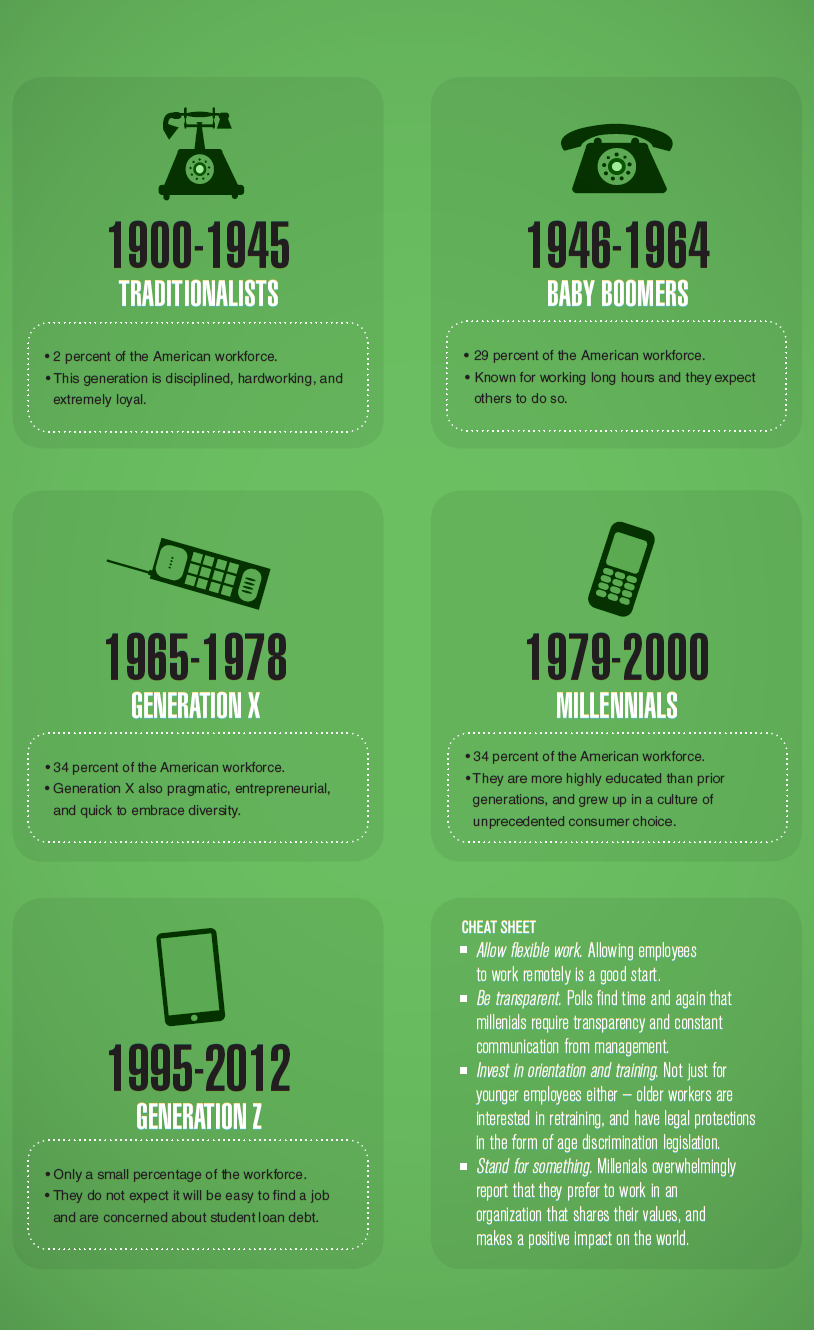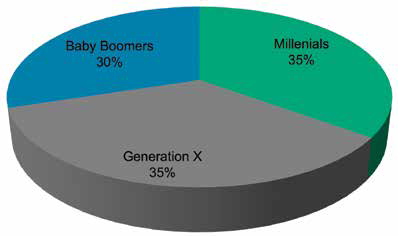
CHEAT SHEET
- Allow flexible work. Allowing employees to work remotely is a good start.
- Be transparent. Polls find time and again that millenials require transparency and constant communication from management.
- Invest in orientation and training. Not just for younger employees either — older workers are interested in retraining, and have legal protections in the form of age discrimination legislation.
- Stand for something. Millenials overwhelmingly report that they prefer to work in an organization that shares their values, and makes a positive impact on the world.
The workforce today is comprised of five generations, making it more diverse than ever before. While differing generational attitudes and stereotypes can cause friction, there are some specific and deliberate steps that in-house counsel can take to make a more adaptive, high-performing workforce. This article surveys the different generations that make up today’s workforce and provides ideas about the solutions employers can take to harness the collective wisdom and strengths of those generations.
Generational characteristics
It would be short-sighted to assume that each individual is defined solely by his or her generation. However, many studies suggest that historical events, societal influences, and advances in technology have shaped the various generations, causing defined traits and attributes. These traits and attributes help us understand why employees of different ages have different approaches to work.
Traditionalists, who now comprise only two percent* of the current American workforce, were born between 1900 and 1945. Their formative years were marked by worldwide economic depression and World War II. This was a time of strong nuclear families and parents who were disciplined and strict. As a result, this generation tends to be conservative in their appearance and language. As workers, they are disciplined, hardworking, and extremely loyal. They see work as a privilege and value stability. They follow the rules and only later ask “why” if they have a concern.
Baby boomers were born between 1946 and 1964. They experienced the Cold War, Vietnam, the assassinations of John F. Kennedy and Martin Luther King, Watergate, the first moon landing, and significant advancements in civil rights. They saw the advent of tape decks, VCRs, and personal computers. The baby boomer generation currently makes up 29 percent* of the American workforce. They are generally working longer than anticipated, and longer than prior generations. The percentage of boomers in the workplace is closer to 10 percent in Europe, where private and state retirement benefits are generous and retirement can, in some circumstances, be compelled by law. Boomers are known for working long hours and they expect others to do so as well. Boomers often have a competitive streak and believe that everybody should be required to “pay their dues.” They tend to have a unilateral leadership style and while they inform their team of decisions that have been made, they frequently do not involve them in making the decisions.
Generation X makes up 34 percent* of the American workforce. They were born between 1965 and 1978 and were influenced by the fall of the Berlin Wall, the Iran Contra Affair, Operation Desert Storm, and rising levels of divorce. On the technology front, they were the first generation to use personal computers and embrace the internet. They also saw the rise of video games and the creation of MTV and mobile phones. Generation X is resourceful and independent, having grown up as women returned to the workforce and they returned to empty homes after school earning them the moniker “latch key kids.” They are also pragmatic, entrepreneurial, and quick to embrace diversity. Their leadership style is one of coaching and they often include their teams in decision-making.
Generation Y or “millennials” were born between 1978 and 2000. They have experienced the September 11th attacks, Enron, and the wars in Iraq and Afghanistan. This generation grew up with technology fully integrated into their lives. They first used personal computers as small children. They are sometimes known as the “iPod generation” and saw the creation of Google, as well as social media sites like Facebook, Twitter, and YouTube. These technology influences have made them expect more immediate and transparent responses, and they are more comfortable sharing personal information. Currently, millennials make up 34 percent of our workforce. By 2020, they are expected to comprise half of the global workforce and by 2025, three out of every four workers in the United States will be a millennial. As a result of accelerating baby boomer retirement, millennials will be given high levels of responsibility earlier in their careers than previous generations. They are more highly educated than prior generations, and grew up in a culture of unprecedented consumer choice and commercial spending. They are imaginative, like flexibility, technology, feedback, and teamwork. They are also socially conscious. They partner with others as leaders and they prefer that decision-making is done using a team approach. They were raised by parents who were heavily involved in their lives, encouraged them to pursue their goals, speak up, and ask questions. They are used to a collective process that involves seeking the input of others, and are uncomfortable with ambiguity. They expect those more senior will provide detailed information and specific guidance with each assignment, just as their teachers did in the past. Millennials are often stereotyped as craving recognition, and maybe it isn’t surprising since they grew up getting a trophy for participating, not just winning.
Generation Z is classified as those born between 1995 and 2012. Right now, they comprise only a small percentage of the workforce, many entering during the deepest part of the recession. They do not expect it will be easy to find a job and are concerned about student loan debt. As a result, they tend to rank opportunity for growth higher than other categories, such as flexibility and a friendly work environment. They are hyper savvy when it comes to technology. They typically connect via smartphones and other mobile devices. They are familiar with constant streams of data and expect immediate answers.
Strategies for creating a high-performing intergenerational workplace
There is no doubt the landscape as we know it is changing, the question is how can in-house counsel help employers adapt? Here are some suggestions for ways organizations can implement strategies to leverage generational strengths.
1. Develop a consistent culture on flexible work arrangements
One of the most noticeable shifts in the modern workplace is the desire for flexible work arrangements. Younger workers generally demand more flexibility from their employers, but as baby boomers contemplate reducing their commitment at work or leaving the workforce all together, flexible schedules can recruit millennials and retain the boomers who might otherwise feel they have an “all or nothing” approach to work. Flexible arrangements can also take the form of gradual on-ramping as employees return to work after a leave, job sharing arrangements, or different career progression tracks depending on the variable level of commitment the employee is able to give. While not all positions can be modified to be flexible, these types of arrangements give employees more options to remain engaged and part of the workforce in a more limited capacity. Employers are able to retain high performers who might otherwise leave.
One of the most effective ways to have a flexible workforce is to permit, or even encourage, working remotely. Resistance to remote work tends to grow out of a perception that if someone is not physically in the office, they are not working. This sense is exacerbated when there is a lack of transparency about what work is being done. Publicizing projects and being clear about workflow keep everyone in the loop. Within a corporate legal department, this has the added benefit of reducing the sense that legal department staff are working in “silos”. Requiring employees to maintain open calendars that show when they are available, and having regular team meetings to check on progress can help alleviate those concerns. Video conferencing technology has also made it easier to include staff who work remotely. Being able to see the people you are speaking with is far more inclusive than a voice-only conference call. It goes a long way to normalize remote workers. And companies can support a “work from anywhere” system by providing Wi-Fi compatible technology or router devices that allow employees to replicate the work environment at home. Millennials who don’t mind working until 9 pm as long as they can get in their 5 pm SoulCycle (similar to spinning) class will typically have no problem keeping an up-to-date calendar and an instant messaging app that allows others to get in touch with them quickly, an advantage that in-house counsel with worldwide responsibilities may find both a help and a burden. While being available all the time helps many employees be flexible, it can be difficult to carve out “down time.” Remote work arrangements also help regional businesses access a national talent pool. Baby boomers are more reluctant to leave the area where they have lived for decades for a new job. With more workers than ever in dual-income households, remote work means that the whole family doesn’t have to move when one spouse gets a new job.
But against this backdrop of flexible work arrangements lurks a variety of potential compliance problems. To ensure wage and hour laws are followed, in-house counsel should work with the human resources department to ensure that there are appropriate timekeeping procedures in place. Managers must be trained to ensure all work is accounted for and paid. In the United States, this is critical if your company allows non-exempt employees to have access to their email on their personal devices.
It is important to take adequate security measures to ensure the employer’s systems aren’t open to cyberattack or the disclosure of proprietary information taken outside the office. With over 90 percent of employers allowing employees to access work information on a personal device, a comprehensive approach is necessary. Your IT department is your partner here. Some companies choose to provide all the required equipment so they can ensure it meets their standards. Other companies are comfortable communicating those standards to the employees and letting them select the equipment. Make information about the minimum requirements for remote work available to all employees: This way they will know in advance whether it might be an option for them. All employees who use a personal device to access work information should be provided with written guidelines for access and required to acknowledge their agreement to the company’s rules. The acknowledgment should be clear that the work data accessed on the device belongs to the employer, even if the device is the employee’s property. It is increasingly common for such access to include the employer’s ability to remotely wipe company data off the personal device.
Workplace safety issues also require some planning and creativity. For example, employees working remotely must be able to show they have a private, quiet space to work; liability insurance for their work location; and ergonomic office equipment. Remote work arrangements expand your workplace into virtual spaces that the employer has limited ability to control. The associated risks are best managed when implemented at the beginning. In-house counsel interested in reducing this risk should identify the person or department responsible for workplace safety and involve them to ensure the remote workplace complies with the company’s minimum standards. Real time video communication can be used to assess a remote work location without the added time and expense of an in-person visit by a company representative. As with personal devices, a robust policy on remote work is essential.
2. Transparency and regular communication with senior management
If there are two trends that have emerged from the studies on millennials, it is the importance they place on transparency and their need for feedback. Having grown up in an era in which corporate and political corruption scandals were daily news and having watched their parents’ retirement funds and pensions depleted by economic crises, it is not surprising that millennials tend to be less trusting than prior generations. In an HR Magazine poll of over 1,000 millennials, 60 percent wanted to hear from managers at least once a day. That level of interaction presents a particular challenge for in-house counsel, who are used to working and managing independently. While millennials value transparency, the reality is everyone benefits from a workplace that is more transparent with regard to goals, objectives, and progress made. It aligns expectations, creates a stronger culture of teamwork, and avoids the misunderstandings and negative feelings associated with ambiguity.
Some tools that are effective in the open communication loop are online or in-person forums such as informal “brown bags” with C-level management, more formal “town hall” style meetings about company performance, and maintenance of an internal blog with responses to comments or a closed Twitter account where anyone can express their views. Companies with the best practices for interacting with employees are prepared to answer questions from the audience in live meetings and assign someone to respond to employee posts on internal media.
But it is important to recognize that feedback is not just a one-way street. Providing an avenue for employees to give feedback that goes up the management chain is crucial for retaining millennials, but also lets you hear from Gen Xers who often aren’t outspoken and also to solicit the institutional wisdom of baby boomers who have worked for your company for decades. You may be amazed at the creative ideas your employees have. One leading company has an “innovation prize” that awards a cash bonus to the best idea submitted from its workforce for improving the workplace culture, technology, training, efficiency, and client service.
Open feedback may also help you mitigate risk as employees raise compliance problems early, and surface issues you may not otherwise discover. In an era in which employees can reap a windfall of millions by whistleblowing to regulators, it is all the more critical to encourage internal feedback channels so that compliance issues can be identified and acted on at an early stage.
And what you do with the feedback matters too — letting everyone know how you are responding helps avoid employees feeling like they are just putting it into the ether.
3. Invest through orientation and training
As the generations of baby boomers, Gen Xers, and millennials converge in the workplace, the way they process and understand information differs, as does the way they feel connected and integrated. Employers can foster integration by creating more robust orientations in which new employees are given the opportunity to gain a better understanding of the work culture, environment, and the company. Lowering the barriers between employees is particularly valuable for new in-house counsel. Suddenly being expected to have expertise in a range of legal areas can be intimidating to a veteran lawyer from a firm as much as a fresh young lawyer straight out of law school. Encouraging in-house counsel to ask questions and understand their internal clients leads to a more effective partnership between the legal department and the business.
Additionally, providing adequate training and support for new technology benefits employees who may be reluctant to ask for help directly for fear of negative perceptions. Consider offering “drop in” hours so employees can ask for help in a low-pressure environment. Employers should also think about different ways to present information. For example, bullet-point Powerpoint slides may not be as effective as an app that can be accessed in real-time.
Don’t make the mistake of assuming that only younger workers are interested in developing new skills. Many boomers are interested in transitioning to a new career and will appreciate the training opportunities—career development opportunities should indeed be offered across the board. In fact, neglecting older workers or assuming they are planning an imminent retirement can land your company in hot water with an age discrimination lawsuit. In the United States, only employees over 40 are able to avail themselves of the protections of the Age Discrimination in Employment Act. In other jurisdictions, particularly in Europe, age discrimination laws may protect younger as well as older workers from discrimination based on their age.
US labor force by generation
A 2015 survey by the Pew Research Foundation found that there are roughly the same amount of millenials and Generation X employees in the workplace. The share of baby boomers will continue to decrease, while the next youngest generation will continue to expand.

4. Rewards, recognition, and clear rules regarding compensation and promotion
Millennials have entered the workforce in the midst of skyrocketing student debt and worldwide economic instability, and they pay into entitlements they fear will be unavailable in the future. Combined with the value they place on transparency, a clear set of rules regarding compensation and promotion are important to millennials. They appreciate employers who have clearly communicated the compensation structure and provide a well-defined path to career advancement that enables employees to “step on” or “step off” a promotion track. This also helps the Gen Xers take a step back when they don’t have the time to devote to work, and it assists baby boomers who are interested in ramping down but not leaving the workforce completely.
Providing public recognition is a valuable motivator for behaviors an employer wants to encourage. Employers may choose to have awards for exceeding sales goals, but can also recognize strong mentorship, teamwork, and creating opportunities for others. Saying “thank you” is free. And doing it in a public way, such as in a company blog, live meeting, or on an internal wiki site lets everyone in the organization know about the good work done.
5. Encourage two-way mentoring
With boomers remaining in the workforce longer than prior generations, there is an opportunity for these generations to mentor each other. Older workers are more likely to be in leadership positions due to their tenure in the workplace. Boomers/Gen Xers can share life and work experiences with millennials and they, in turn, can mentor boomers/Gen Xers in areas such as technology, social media, and how to interact with their peer millennials. The opportunity to “manage up” increases the sense of ownership of the work for the younger workers. At the same time, other generations obtain the opportunity to know and learn from the millennials.
6. Create value outside the job
Workers of all ages have suffered from an erosion of trust in institutions. This is most apparent in millennials, who want to work for organizations whose core values they share. They aren’t shy about seeking to incorporate their charitable interests in their work. For many younger workers, the workplace is the new community center. Including family or friends at work events, providing paid time off to volunteer, encouraging pro bono projects, having company-sponsored charity events and community responsibility initiatives are just some ways to foster collaboration on matters that don’t necessarily relate directly to work. The can provide informal opportunities for interaction with more senior colleagues in a less formal setting. In addition to developing valuable shared experiences, such efforts lend a sense of meaning that is sometimes lost in day-to-day duties. These types of activities may have been popularized by start-ups seeking to engage millennials but they will improve workplace culture across the board, while at the same time creating a positive social impact.
7. Inclusive work environment
In addition to the areas discussed above, in-house counsel should consider how their own department’s social culture can impact work. Nowhere do generational differences become apparent more quickly than in different manners of communication. Rather than try to force a specific culture on all your workers, create options that suit different generations. For example, social events don’t need to center around Friday night at a local bar.
Conclusion
The rapidly changing workplace requires creative and adaptive policies. More employers are taking conscious steps towards an inclusive work culture that captures the best of a multigenerational workforce, regardless of age. You don’t need to resign yourself to inherent conflict between your oldest and youngest workers and you don’t need to put a foosball table in the break room to attract younger workers. What helps a younger worker can help an older worker, and vice versa. Considered measures towards flexibility and transparency engage workers and allow in-house counsel to recruit and retain top talent of any age.






